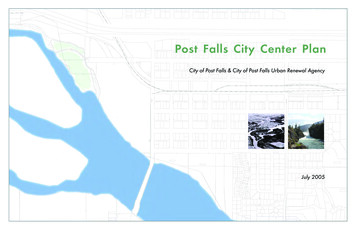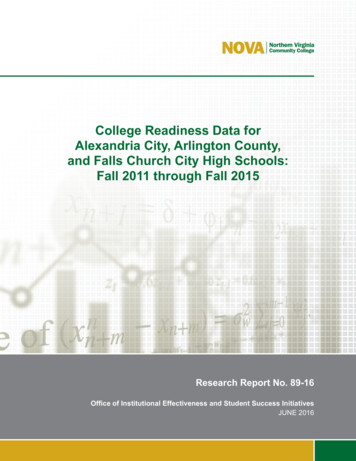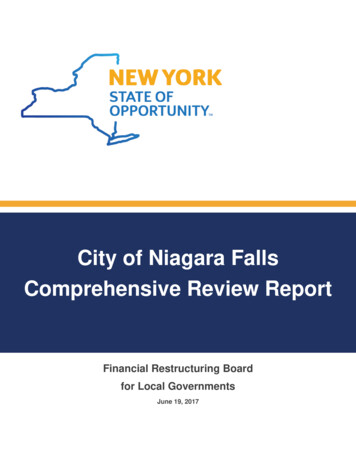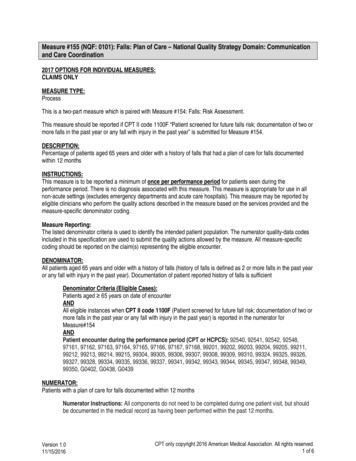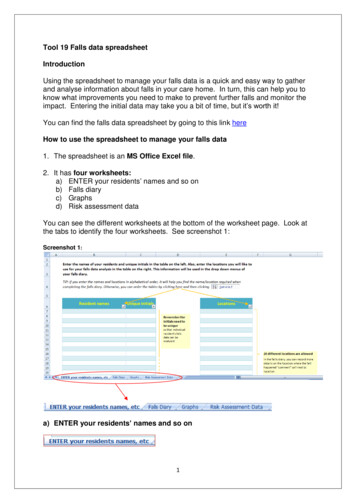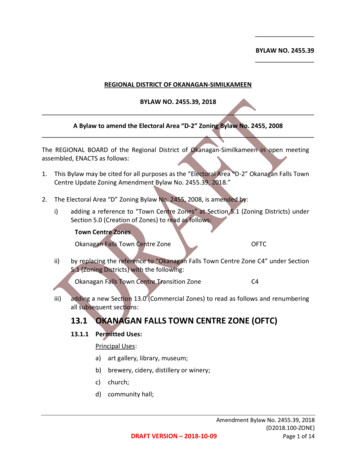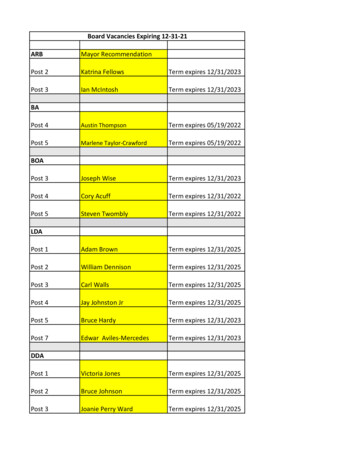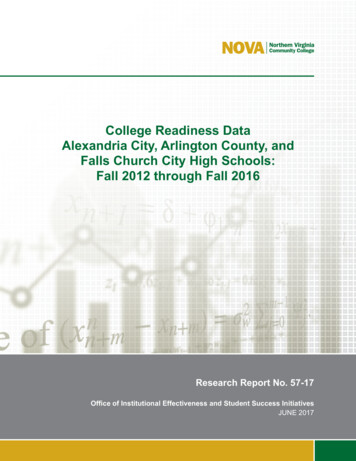
Transcription
City of Post FallsCommunity CenterFeasibility Study
ACKNOWLEDGMENTSMayor and City CouncilMayorRonald G. JacobsonCity Council MembersLinda Wilhelm, Council President – Seat 6Kerri Thoreson – Seat 1Alan Wolfe – Seat 2Joe Malloy – Seat 3Steve Anthony – Seat 4Lynn Borders – Seat 5Parks & Recreation CommissionChairman – James A. Hail IIICommissionersJayson CornwellGeena DuczekScott FinkKrista NoyesDani Zibell-WolfeParks and Recreation StaffDavid Fair, Parks & Recreation DirectorBryan Myers, Parks ManagerTraci Stevenson, Recreation ManagerRobert Quinn, Parks PlannerConsultant TeamGreenPlay, LLCRRC AssociatesBernardo Wills Architects PCFor more information about this document, contact GreenPlay, LLCAt: 1021 E. South Boulder Road, Suite N, Louisville, Colorado 80027, Telephone: 303-439-8369Email: info@greenplayllc.com www.greenplayllc.comCommunity Center Feasibility Studyi
Table of ContentsPurpose of This Study. 1I. Community Center Vision. 3A. Next Steps . 3II. Planning Process. 5III. Program Identification and Site Analysis. 7B. Program Summary. 8C. Concept Development. 9D. Site Analysis. 15E. Decision Making Matrix . 16IV. Operational Budget Estimates Pro-Forma. 17A. Operating Budget Purpose. 17B. Overall Budget. 17V. Preliminary Project Construction Costs . 21VI. Needs Assessment and Community Input. 23A. Random Invitation Community Survey Summary . 23B. Specialty Features Survey Preference. 26Table of FiguresFigure 1: Timeline for Project Implementation.4Figure 2: First Floor Map.9Figure 3: Second Floor Map.12Figure 4: First Floor Concept Development.14Figure 5: Second Floor Concept Development.14Figure 6: Site Analysis.15Figure 7: Decision Making Matrix Rankings.16Figure 8: Decision Making Matrix Combined Rankings.16Figure 9: Operations and Maintenance Summary.20Table of TablesTable 1: Community Center Components.8Table 2: 2020 Square Foot Cost Estimates.21iiCommunity Center Feasibility Study
Purpose of This StudyThere are many considerations to be made in the development and activation of a community center. Asa planning document, a Feasibility Study does not have design absolutes. The actual designs and specificamenities and their sizes come later in the process as the project moves to the actual design phase. Thisstudy looked at the appropriate mix of programs and amenities for a new proposed community center,determined a projected range of construction costs associated with building the center, determinedthe potential cost recovery, and summarized the costs of operating the center. It also explores potentialphasing options for the project. The study will assist the City of Post Falls in determining the necessarybuilding elements to meet the expectations of the community, and support current and growth relatedprogram needs identified in the 2020 Parks and Recreation Master Plan.Community Center Feasibility Study1
THIS PAGE IS INTENTIONALLY LEFT BLANK2Community Center Feasibility Study
I. Community Center VisionTo capture the vision for a community center, the project team of GreenPlay, Bernardo/WillsArchitecture, and Post Falls Parks & Recreation staff worked together with city staff from otherdepartments to engage the Post Falls community. The information gathered from this project specificcommunity engagement effort was supported by the community input gathered during the 2020 Parksand Recreation Master Plan.The project team assembled the information, confirming components, programming, and communityneeds to develop the following vision items: Design for all ages and abilities (inclusivity) Community destination Affordable Family focused Opportunity to explore recreation and wellness Sustainable Expansion potential/phasing optionsThe following recommendations are made based on the entirety of the feasibility study which wasinclusive of members of the community, and the public was given several opportunities to participatethrough charettes and public meetings.A. Next Steps1. Create a phased action plan- This plan should consider as much as possible other relevant cityplanning documents. (i.e. the City Center Plan & the City Center Parking Plan and the DowntownArea Feasibility Study, 2020 Master Plan and City Comprehensive Plan). The resulting action planshould work to align strategic initiatives in place in order to maximize the City Project Funds and newconstruction efforts.2. Establish necessary steering committees and boards- These groups should be assembled to overseethe funding initiative, land acquisition, design review, etc.3. Engage the Community - Continue to engage the community to distill the strategic vision for thecommunity center increase involvement, build consensus, and create a sense of ownership.4. Vision Testing - As part of future strategic visioning and community engagement. Involve thecommunity to inform the best phasing options to fulfill the Community Center Plan and leveragepotential funding. Develop rating criteria for prioritizing objectives and outlining a schedule oftasks for determining the facility elements to be included in each phase. Determine the cost ofconstruction and operations for each phase of the project.5. Land Acquisition - As part of future strategic visioning, identify land parcels the City will need toacquire to fulfill the Community Center Plan. Develop rating criteria for prioritizing objectives andoutlining a schedule of tasks for acquiring the individual land parcels. Determine the dollar value forthe land needed for acquisition.6. Establish Phasing Strategy - take conceptual plans to the next steps and determine phasing options.As part of establishing a phasing strategy, identify best phasing options to fulfill the CommunityCommunity Center Feasibility Study3
Center Plan. Develop rating criteria for prioritizing objectives and outlining a schedule of tasks fordetermining the facility elements to be included in each phase. Determine the cost of constructionand operations for each phase of the project.7. Identify Funding Sources and Development Timeline - Identify Private and Public Funding Sourcessuch as general obligation bonds, impact fees, federal and state grants, that the City will need topursue in order to attain the necessary funds for the Community Center. Outline a schedule of tasksfor securing the necessary funding for each phase of the project implementation.8. Timeline for Implementation - The following graphic shows the potential timeline forimplementation of the recommendations (as per the Washington State Architects/Engineers Fees forPublic Works Building Projects, 2015 ed.). This timeline assumes that the Public Information/Briefingand the Fund Raising/Land Acquisition Phases have been already accomplished.Figure 1: Timeline for Project Implementation4Community Center Feasibility Study
II. Planning ProcessA comprehensive planning process was conducted in concert with the 2020 Parks and Recreation MasterPlan by the project team to develop the vision and potential program for a community center. GreenPlaycollected and reviewed all information provided to help determine the current and future needs in thecommunity that could inform the development of this study. Some of these documents include; the2020 Parks and Recreation Master Plan, survey results from the Master Plan and the City of Post FallsComprehensive Plan. The related survey results can be found in the end of this document.After reviewing all the applicable data: The project team conducted a series of public outreach meetings. These generally included city staffand stakeholder interviews and four community workshops to confirm programming, activity, andservice needs, along with desired facility elements and conceptual designs. Following the public outreach, the project team ranked and prioritized demand, opportunities, andpublic input to develop a community center program. This was then followed by a site analysis to determine if the community has potential sites availablethat could viably support a community center. Once the facility program was identified, financial considerations were identified to help guide theCity on future decisions relating to facility design. Recommendations were developed with goals, objectives, and an action plan to help guide the Citywith developing a successful community center.The team determined potential conceptual designs, and capital and operating costs associated with theproposed facility along with potential avenues for funding construction and recovering a portion of theoperational costs.Community Center Feasibility Study5
THIS PAGE IS INTENTIONALLY LEFT BLANK6Community Center Feasibility Study
III. Program Identification andSite AnalysisA. Program IdentificationThe following building program was established to address the desired program and activity needsfor Post Falls residents. The following list of components was developed to serve as a benchmark forpossible building sizes and ultimate land acquisition recommendations.Potential building and outdoor support components: Rooms for Birthday rentalsFitness/WellnessCardioWeight equipmentGroup Exercise RoomsRacquetballFunctional fitness spaceMulti-purpose spaceClassrooms (2-3)Multigenerational SpaceEsportsGathering spaceMeetings rooms (3 rooms that open up to fit250 people table and chairs, separate entranceability)Rooms for private health care providerCatering/Teaching kitchenondoor playgroundChild care (during facility olLobbyClimbing wallConcessions/vending Staffed spaceFood storageMaker space if it can be doneConnection to the outdoorOutdoor playgroundsCatering pull upPlazas, outdoor covered patiosWalking trailOutdoor group exercise spaceGymnasium - three courts (high school size) rollout seating or view spaces Basketball, volleyball, pickleball,badminton, active exercise (electronics)Suspended track, adventure track (possiblygoing outside the facility)Aquatics - recreational pool, instructional design with expansion ability for competitionIndoor turfField houseCommunity Center Feasibility Study7
B. Program SummaryFollowing identification of the major programming elements, a complete building program wasdeveloped to determine an ultimate building square footage. This data is designed to assist the City ofPost Falls in determining future land acquisition needs associated with selected building components,along with an estimated project budget. It’s important to note that all components may not necessarilybe implemented at once or in the same building or location. The Community Center total area of 13.19acres would be required if all components were desired to be implemented at one site.Table 1: Community Center ComponentsA. Operations - Building SupportEntry LobbyReception / Access Control / RegistrationVending AlcoveCabanas - Unisex - Dry (8x12)Cabanas - Unisex - WetLockers - Unisex - DryLockers - Unisex - WetFamily Changing Rooms (10 @ 90sf ea.)Gender Neutral Changing (2 @ 90 sf ea.)Public Restroom - Unisex (60sf ea.)General Building StorageCustodial Maintenance OfficeMaintenance / Receiving / StorageSubtotal: Building Support SpacesB. Operations - Facility AdministrationDirectorFacility Manager OfficeAssistant Facility Manager / OperationsProgram Coordinator's Office (2 - 120sf ea.)Program Staff Offices (3 - 80sf ea.)Meeting / Conference Room (20 person)Staff BreakroomStaff Restroom - UnisexWorkroom / Storage / SuppliesSubtotal: Facility AdministrationC. Aquatic SpacesRecreation Pool Water (water 4,000sf)8-Lane 25 Yard Pool (water 5,380 sf)Spectator Seating (200 seats sf)Outdoor SplashpadTherapy Pool (20 person)Whirlpool/Spa (includes deck, 10-12 person)Outdoor Whirlpool/Spa (includes deck, 10-12 person)Sauna (150sf)Aquatic Supervisor's OfficeAquatic's Office (2 staff)First Aid RoomLifeguard Changing / BreakroomPool Storage (general / team)Pool Mechanical & Heater RoomsPool Sanitation Storage RoomOutdoor Recirculating SplashpadSubtotal: Aquatic Spaces8Community Center Feasibility StudyCOMMUNITY CENTERD. Activity 01205009,580Total Sq. Ft.Total Sq. Ft.200180100240240600300964002,356Total Sq. 01,1001401,00025,240Total Sq. Ft.Multi-Purpose Gymnasium (3 courts @ 50 x 74)18,800Gymnasium Storage2,000Suspended Adventure Track4,000Rock Climbing / Bouldering1,200Child Care / Indoor Playground2,400Child Care / Indoor Playground Storage300Child Care/ Indoor Playground Restroom100Functional Fitness Space(Large)2,400Functional Fitness Storage300Multi-Purpose Exercise (2 -Small)6,000MP Small Storage480Weight Room4,300Cardio4,300Fitness Coordinator Office100Indoor Turf Field - Large (200'x85') Buffer Space/Batting25,200Racquetball (3 court @ 20 x 40)3,200Subtotal: Activity SpacesE. Community SpacesTotal Sq. Ft.Subtotal: Community SpacesF. Community Center Outdoor SpacesTotal Sq. Ft.75,080Casual Activities Lounge (multi-generational)1,000Game Room (multi-generational)1,400GR Storage150Community Room - 100 Seated (Divisible into 4 or 2 Rooms)3,600CR Storage (tables, chairs)500CR Activities Storage300CR Caterer's / Teaching Kitchen800CR Public Restroom - 2 unisex800Special Events / Birthday Party Room (30 person)800Special Events / Birthday Party Room (10 person)350SE/BP Room 91,000452,740Outdoor PlaygroundsPlazas and Outdoor PatiosWalking TrailOutdoor Group ExerciseParking (472 Stalls/257/325)Outdoor FieldsLandscape Buffer/Perimeter/StormwaterSubtotal: Outdoor SpacesTotal Sq. Ft.Community Center Building Net IndoorMech., Circulation, wall thickness (25%)COMMUNITY CENTER BUILDING SF (Without Outdoor Spaces)AcresCommunity CenterOutdoor SpacesAcresCommunity Center Total 1013.19
C. Concept DevelopmentFollowing program identification, a concept was developed to validate the program assumptions, confirmsupport space needs, study building elements and adjacencies, and identify any other factors that mayinfluence either the size of the site, project budget, or operational cost assumptions.The following diagrams and images depict examples of the major building elements recommended.Building Floor Plans and ImagesFirst FloorFigure 2: First Floor MapOps. BuildingSupportOps. pacesCirculationAreaPreviousBuilding PhaseCommunity Center Feasibility Study9
First Floor ImagesFitness center to includecardiovascular and weighttraining equipment.E-Sports areaChildren’s play area to include safe andchallenging activities and equipmentfor multiple ages and levels of abilities.Casual lounge/game room area for useby all ages and abilities.Multipurpose space for meetings, banquets,and special functions.10Community Center Feasibility StudyMultipurpose space for groupexercise and fitness classes.Multipurpose space for additionalactivities.Cafe to provide additional communitygathering space.
Gymnasium, Track, & Aquatics ImagesGymnasium to provide court space for basketball, volleyball,pickleball, and more.Aquatic spaces to include instructional, recreational, leisure and competitive opportunities.Community Center Feasibility Study11
Second FloorFigure 3: Second Floor MapOps. BuildingSupport12Ops. FacilityAdminCommunity Center Feasibility culationAreaPreviousBuilding Phase
Second Floor ImagesIndoor walking/running/activity trail to allow all ages and abilities to move throughout the facility.Indoor Turf and Field HouseIndoor field house with turf allowing outdoor field activities to come indoors.The following diagrams represent the concept developed to include all components from the programsummary for this study (a. building first floor plan, b. building second floor plan). The location on whichthe concept has been placed is meant only to show the amount of land required and how the facilityelements of a community center could potentially be placed on a site, with specific regards to outdoorspaces such as a parking lot and sports field. This specific site has not been identified as a preferred siteat this time.Community Center Feasibility Study13
Figure 4: First Floor Concept DevelopmentFigure 5: Second Floor Concept Development14Community Center Feasibility Study
D. Site AnalysisUpon completion of the program identification and concept development, a site analysis was performed.The intent of the site analysis was not to identify a specific site, but rather determine if the communityhas potential sites available that could viably support a new community center. In addition, the siteanalysis also provided valuable assumptions that influenced the development of the project budget. Thegreen dots represent areas community members envisioned for the community center. The three areasof greatest interest were near the Montrose subdivision, Tullamore subdivision, and at the end of 3rdAve. near the Millennium Skate Park.It is our recommendation that once funding is secured for the project, a formal process for site selectionshould be conducted which will allow for further analysis of items such as infrastructure availability, landcost, future development, visibility, access, and site-specific characteristics that may be valuable to a newfacility.The image below indicates the identified sites.Figure 6: Site AnalysisCommunity Center Feasibility Study15
E. Decision Making MatrixThe Decision-Making Matrix was developed to assist the City of Post Falls with making future siteselection and future decisions regarding facility elements for a Community Center. Figures 7 and 8 showtwo of the worksheets included in the matrix.Figure 7: Decision Making Matrix RankingsFigure 8: Decision Making Matrix Combined Rankings16Community Center Feasibility Study
Operational Budget EstimatesIV. Pro-FormaGreenPlay conducted a financial analysis and developed operational budgets and pro-forma budgetsfor the proposed development of a new community center. These are based upon industry standardlook and not upon a specific design. Operating expenses include staffing, contractual services, andcommodities. Revenue includes daily user fees, memberships, and rental fees.A. Operating Budget PurposeThe operating budget is driven by the overall service philosophy, which should define Post Falls facilitiespurposes, including who the facilities are going to serve, and at what level the service is going to beprovided and the hours of operation.B. Overall BudgetIt is a goal to minimize the amount of subsidy necessary to operate a community center. Normally, itis extremely difficult for public recreation facilities to be run without subsidy and operate solely fromthe collection of fees and charges and alternative funding such as grants, philanthropic gifts, generalfund taxes, or volunteers. With this in mind, the operational budget planning for this facility usesa conservative approach to estimating reasonable expenses and moderate approach to projectingrevenuesWhile this initial budget provides a baseline during the initial operation, it is possible that revenues andexpenses could change as this facility experiences several years of operations. It should be noted that ittakes three to five years to achieve full revenue potential. There is no guarantee that the estimates andprojections will be met, and there are many variables that cannot be accurately determined during thisconceptual planning stage or may be subject to change during the actual design and implementationprocess. The budget estimates should be revisited in more depth after the first year of operation of thefacility by building a ground-up costs and revenue projection using local experience.Assumptions Budget is calculated in 2020 figuresCosts for new staff are included in expensesFitness center space is not staffedRecreation programs operate at revenue neutralStaffing Plan and O & M Budget Developed Assuming the Following:Community Center Community Center open year round Hours of operations Monday – Friday 8 am – 10 pm Saturday & Sunday 8 am – 8 pmCommunity Center Feasibility Study17
Opportunities for Revenue Generation: Membership sales and daily admission sales for informal recreationFacility Rentals Birthday rentals Functional fitness space Multi-purpose space Large multi-purpose space Small multi-purpose space Classrooms Large multi-purpose space (dance) Small multi-purpose space (crafts) Meetings rooms Rooms for private health care providers Catering/Teaching kitchen Climbing wall rentals Community Center after hour rentals Community Room Large banquet space Plazas, outdoor covered patios Outdoor group exercise space Outdoor fieldsStructured recreation programs that operate at revenue neutral: Group exercise Fitness, Health, and Wellness programs Lifelong learning classes Racquetball programs Special interest programs Basketball leagues Volleyball leagues Pickleball Indoor soccer, lacrosse, softball, baseball Preschool/afterschool programs Child-care (during facility use)Expenditures Generally, personnel costs make up the single highest expense for most multi-purpose recreationfacilities, often up to 70 percent of the operational budget. The estimated utility costs for the volume of space within the facility accounts for a high percentageof the services budget and was projected by Post Falls staff and consultant team. Other typical services include contracted instructional services, marketing and advertising, printingand publishing, travel and training, subscriptions and memberships, telephone, bank chargesand administrative fees, miscellaneous service charges (permits, licenses, taxes, fees), buildingand equipment maintenance (contractual or rental services), other contracted services (custodialservices, security and fire systems, elevator, garbage pick-up, etc.), utilities, property and liabilityinsurance, building maintenance, and repair.18Community Center Feasibility Study
Expenditure estimates are based on the type and size of the activity, support spaces in the facility, andthe anticipated hours of operation. When possible and wherever available, calculations are based onactual best practice or methodology. All other expenses are estimated based on the consultant team’sresearch and reported experience at similar facilities.The consultants have the following recommendations for consideration: Capital Replacement Fund - should be added to the budget at approximately two percent ofexpense budget to purchase capital replacement items for the facility when necessary. Equipment Replacement Fund - should be added to the budget at approximately one percentof expense budget to purchase replacement or new fitness equipment for the facility whennecessary. All computers, registrations system, software, etc. will be included in the Furniture, Fixtures, andEquipment (FFE) list and funded through the capital budget and are not included in the operationaland maintenance budget.RevenuesRevenues are forecast based on anticipated drop-in fees, punch card and pass sales, and rentals aroundanticipated scheduled programming. The preliminary budget projects structured/pre-registeredprogram revenue at 100 percent cost recovery for direct costs and are not therefore included in therevenue or expense projections. Revenue projections consider program and facility components,multiple admission and age discounts, and political and economic realities.Revenue forecasts are based on the space components included in the facility, the demographics of thelocal service area, and the current status of alternative providers in the service area. Actual figures willvary based on the final design of the facility and the activity spaces included, the market at the timeof opening, the designated facility operating philosophy, the aggressiveness of fees and use policiesadopted, and the type of marketing effort undertaken to attract potential users to the facility. Therevenue forecast will require a developed marketing approach by staff in order to meet revenue goals. Pass holders can participate in self-directed activities, including group fitness, and may payadditionally for other activities. It is recommended that there will be no contracts, initiation fees, or registration fees associatedwith the daily passes. Automatic debits from checking accounts, savings accounts, or credit cards may be an option andnot mandatory for passes. Merchandise resale was not factored into the projections. Vending revenue was not factored into the projections.Preliminary projections indicate that full build out could operate at 136% cost recovery. The NRPA 2020Agency Performance Review indicates the typical agency recovers 25.9% of its operating expendituresfrom non-tax revenues. Nationally recreation centers operate with 51.1% cost recovery per recentRecreation Management 2020 State of the Industry Annual Report.Community Center Feasibility Study19
Figure 9: Operations and Maintenance SummaryPost Falls Community Center Operations & Maintenance SummarySample Operational Budget ProjectionsNo guarantee is being implied by GreenPlay that these projections will be obtainedTOTAL EXPENSES 720,928Full-time staffing 246,176Part-time staffing 238,587Contractual Services 295,296Commodities 76,020 0TOTAL REVENUE 978,475Passes 264,750Rentals 346,900Event Services 43,625Recreation Programs 232,000Entrance Fees 84,200Concessions 7,000TOTAL NET 257,547COST RECOVERY136% 0Reallocation of Currently Budgeted Expenses 0Total Amou nt of New Operating Fu nds Requ ested 020Community Center Feasibility StudyCrown Mountain Community Recreation Center
V. Preliminary ProjectConstruction CostsThe following square foot costs are estimates for future construction based on 2020 costs. Once theactual facility program is identified, projected construction costs would need to be developed.Table 2: 2020 Square Foot Cost EstimatesCommunity Center Feasibility Study21
22Community Center Feasibility Study
Needs Assessment andVI. Community InputA. Random Invitation Community Survey SummaryAs part of the 2020 Parks and Recreation Master Plan a needs assessment was conducted. The followingis information specifically relevant to this feasibility study.Top Ranked Priorities for the FutureWhen asked to prioritize their responses, aquatic facilities rise to the top for both invite (25%) and openlink (28%) respondents.Respondents see a primary purpose for the future to be providing clean, well-maintained parks andfacilities (4.5). Promoting healthy active lifestyles (4.2) and connecting people with nature (4.0) were alsoseen as important among both invite and open link respondents.Among facilities that are not meeting the community’s needs as well, indoor recreation facilities (3.6),indoor athletic courts (3.6), water access/facilities (3.7), and the Post Falls Community Garden (3.7) werelowest in how well they were
Community Center Feasibility Study 3 I. Community Center Vision To capture the vision for a community center, the project team of GreenPlay, Bernardo/Wills Architecture, and Post Falls Parks & Recreation staff worked together with city staff from other departments to engage the Post Falls community. The information gathered from this project .
